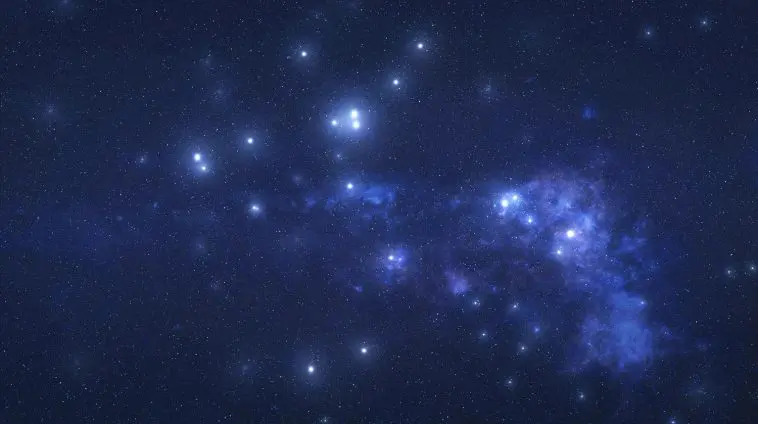[Originally published as the second part of Stellar Astronomy: Part 1 – Distance and Brightness. Continued from Studying the Stars: Distance]
Once the distance to a star is measured, the intrinsic luminosity of the star can be computed from its observed brightness. If you hold a lit candle one foot away from your face, it will appear quite bright. But the same candle a mile away would barely be visible even at night. The luminosity of the candle did not change; it emits just as much light regardless of its distance from the observer. The amount of light that our eyes receive from the candle diminishes with distance.
This is apparent brightness: how bright something appears at a distance.
The apparent brightness of an object is inversely proportional to the square of its distance from the observer. That is, if you double the distance to a candle, it will appear one-fourth as bright. This geometrical principle allows astronomers to compute the true luminosity of any star if we know the distance to the star. We measure the apparent brightness using a photometer and then multiply by the square of the distance to determine the true, intrinsic brightness — its luminosity. Astronomers have performed such computations for many stars. These computations confirm that stars do have luminosities comparable to the sun.
The Magnitude System
The ancient Greeks had already developed a system for categorizing the apparent brightness of a given star in our night sky. They divided stars into six classes of magnitude. The brightest stars were said to be first magnitude. The faintest stars were sixth magnitude. This was a crude system because estimates were made by eye and were somewhat subjective.
Modern astronomers have modified and refined this system to make it objectively quantifiable. On our modern system, a magnitude difference of 5 is defined to be an apparent brightness ratio of 100. That is, a first-magnitude star appears exactly 100 times brighter than a sixth-magnitude star.
For a difference of one magnitude, the ratio of apparent brightness is the fifth root of 100, which is approximately 2.512. On this modern system, the faintest stars visible to the unaided eye are still around magnitude 6, but the very brightest stars actually have a magnitude that is negative. Sirius (the brightest star in our night sky) has a magnitude of -1.46. The sun has a magnitude of -26.74.
The magnitude system is a bit counterintuitive to the uninitiated because it is “backward” and logarithmic. By “backward,” I mean that bright stars have a lower magnitude than fainter stars. And it is logarithmic in that a difference in magnitude between two stars corresponds to their brightness ratio and not brightness difference. This allows us to express an enormous range of brightnesses using relatively small numbers. The sun with a magnitude -26.74 is brighter than a sixth magnitude star by a factor of 12.5 trillion!1
The magnitude of a star refers to how bright it appears to be for us as we observe it in our night sky. To emphasize this, we also refer to this as the “apparent magnitude” of a star. Apparent magnitude is symbolized by the lowercase letter m.
But sometimes we want to examine the luminosity of a star — how bright it really is regardless of how dim it may appear due to its distance. To express this, it can be convenient to use the same “backward,” logarithmic system as apparent magnitudes. So, astronomers also use a system called absolute magnitude, symbolized by a capital M.
By definition, the absolute magnitude of a star is the apparent magnitude it would have if it were exactly 10 parsecs away from us. Most stars are farther than this, so their apparent magnitude is greater (fainter) than their absolute magnitude. The sun has an absolute magnitude of 4.83. Since its apparent magnitude is much smaller (-26.74), this shows that the sun is much, much closer than 10 parsecs.
When the word magnitude is used without a prefix, apparent magnitude is implied.
The relationship between apparent magnitude (m), absolute magnitude (M), and a star’s distance in parsecs (D) is simple: m – M = 5 log10(D/10). Since this equation has only three variables, you can always determine the third if you know the other two.2
For nearby stars, we can use the measured parallax to determine the distance, and we can measure the apparent magnitude directly with a photometer. We then compute the absolute magnitude. However, there are certain kinds of stars whose absolute magnitude can be determined by other means. By measuring the apparent magnitude of these stars, we can compute the distance. This is one of the methods that works far beyond the limit of the parallax method.
Now that we know the distances to many stars by the parallax method, and measuring their apparent magnitude with detectors, we can compute the absolute magnitude corresponding to their true luminosity. We find that stars have a wide range of luminosities, but they can all be compared to the sun.
The faintest stars have a luminosity ten thousand times fainter than the sun, but the brightest stars have a luminosity of a million suns. Anaxagorus and Aristarchus were right: stars are just as bright as the sun, but they are at much greater distances.
However, the fact that stars are as bright as the sun doesn’t mean that they are the same type of thing. How do we know what stars are made of, and do they have the same composition as the sun? We will explore this in the next article.
Footnotes
- It is truly amazing that our eyes have such an astonishing range of brightness detection. We can see the sun during the day (do not stare!) and at night those same eyes can see stars that are 12.5 trillion times fainter than the sun.
- This ignores complications such as intragalactic extinction. Intervening material can cause a star to look a bit fainter than it would if the space between stars were completely empty. This effect is usually small but can be important in certain circumstances.







